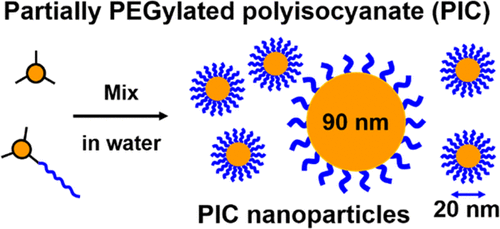当前位置:
X-MOL 学术
›
ACS Appl. Polym. Mater.
›
论文详情
Our official English website, www.x-mol.net, welcomes your feedback! (Note: you will need to create a separate account there.)
Characterization of an Aqueous Dispersion of a Hydrophilic Polyisocyanate for Waterborne Two-Pack Polyurethane Coatings
ACS Applied Polymer Materials ( IF 5 ) Pub Date : 2020-03-17 , DOI: 10.1021/acsapm.9b01173 Hang Zhou 1 , Yang Liu 1 , Margaret Zhang 1 , Yijie Lu 1 , Loryn P. Arnett 1 , Mohsen Soleimani 2 , Mitchell A. Winnik 1, 3
ACS Applied Polymer Materials ( IF 5 ) Pub Date : 2020-03-17 , DOI: 10.1021/acsapm.9b01173 Hang Zhou 1 , Yang Liu 1 , Margaret Zhang 1 , Yijie Lu 1 , Loryn P. Arnett 1 , Mohsen Soleimani 2 , Mitchell A. Winnik 1, 3
Affiliation

|
Waterborne two-component polyurethanes (WB 2K-PUs) represent an environmentally friendly alternative to solvent-borne coatings, with reduced use of volatile organic compounds (VOCs). These coatings still cannot achieve the outstanding performance of solvent-borne 2K-PU formulations. In many WB 2K-PU formulations, a key step involves coalescence between polyol latex particles and nanoparticles formed from a water-dispersible polyisocyanate (PIC). Interactions between the PIC and the polyol take place both in the aqueous medium and after application of the coating to a substrate. A deeper understanding of this mechanism should guide improvements in formulations to improve WB 2K-PU coating performance. Our long-term goal is to investigate the film formation mechanism of a series of different polyol nanoparticles with aqueous dispersions of PICs based on a hexamethylene diisocyanate (HDI) trimer; as a first step in this direction, we examined the nature of the nanoparticles formed by dispersing an oligo-ethylene glycol (OEG)-modified HDI trimer in water. Typical techniques for nanoparticle size characterization (dynamic light scattering (DLS) and capillary hydrodynamic fractionation chromatography, (CHDF)) led to misleading information. These techniques indicated the presence of uniform nanoparticles with a diameter of ca. 100 nm that persisted for days. In contrast, DOSY 1H NMR gave a diameter of 20 nm. Nanoparticle tracking analysis (NTA) confirmed the presence of the larger particles, but showed that they represented only 18 wt % of the dispersion. Over time, the isocyanate groups in the particles reacted with water, and the nanoparticles evolved from liquid droplets to mechanically robust polyurea particles. At this stage, imaging by electron microscopy showed a predominance of 20 nm particles. The kinetics of this chemical transformation was monitored by Fourier transform infrared (FT-IR) spectroscopy. The reaction of the isocyanate groups followed pseudo-first-order kinetics with a half-life of 11 to 14 h.
中文翻译:

水性两包聚氨酯涂料的亲水性多异氰酸酯水分散体的表征
水性双组分聚氨酯(WB 2K-PU)代表了溶剂型涂料的环保替代品,减少了挥发性有机化合物(VOC)的使用。这些涂料仍无法获得溶剂型2K-PU配方的出色性能。在许多WB 2K-PU配方中,关键步骤涉及多元醇胶乳颗粒与由水分散性多异氰酸酯(PIC)形成的纳米颗粒之间的聚结。PIC和多元醇之间的相互作用既发生在水性介质中,也发生在将涂料施涂到基材上之后。对这种机理的更深入的了解应指导配方的改进,以提高WB 2K-PU涂层的性能。我们的长期目标是研究一系列基于六亚甲基二异氰酸酯(HDI)三聚体的PICs水分散体的多种多元醇纳米颗粒的成膜机理;作为朝这个方向迈出的第一步,我们研究了通过将低聚乙二醇(OEG)改性的HDI三聚体分散在水中而形成的纳米颗粒的性质。用于纳米粒度表征的典型技术(动态光散射(DLS)和毛细管流体动力学分级色谱(CHDF))导致产生误导性信息。这些技术表明存在直径大约为1的均匀纳米颗粒。100 nm持续了几天。相比之下,DOSY 我们研究了通过将低聚乙二醇(OEG)改性的HDI三聚体分散在水中而形成的纳米颗粒的性质。用于纳米粒度表征的典型技术(动态光散射(DLS)和毛细管流体动力学分级色谱(CHDF))导致产生误导性信息。这些技术表明存在直径大约为1的均匀纳米颗粒。100 nm持续了几天。相比之下,DOSY 我们研究了通过将低聚乙二醇(OEG)改性的HDI三聚体分散在水中而形成的纳米颗粒的性质。用于纳米粒度表征的典型技术(动态光散射(DLS)和毛细管流体动力学分级色谱(CHDF))导致产生误导性信息。这些技术表明存在直径大约为1的均匀纳米颗粒。100 nm持续了几天。相比之下,DOSY1 H NMR给出直径为20nm。纳米颗粒跟踪分析(NTA)证实了较大颗粒的存在,但显示它们仅占分散体的18 wt%。随着时间的流逝,颗粒中的异氰酸酯基与水反应,纳米颗粒从液滴演变成机械强度高的聚脲颗粒。在此阶段,通过电子显微镜成像显示出占优势的20 nm颗粒。通过傅立叶变换红外(FT-IR)光谱监测该化学转化的动力学。异氰酸酯基团的反应遵循假一级反应动力学,半衰期为11至14小时。
更新日期:2020-04-23
中文翻译:

水性两包聚氨酯涂料的亲水性多异氰酸酯水分散体的表征
水性双组分聚氨酯(WB 2K-PU)代表了溶剂型涂料的环保替代品,减少了挥发性有机化合物(VOC)的使用。这些涂料仍无法获得溶剂型2K-PU配方的出色性能。在许多WB 2K-PU配方中,关键步骤涉及多元醇胶乳颗粒与由水分散性多异氰酸酯(PIC)形成的纳米颗粒之间的聚结。PIC和多元醇之间的相互作用既发生在水性介质中,也发生在将涂料施涂到基材上之后。对这种机理的更深入的了解应指导配方的改进,以提高WB 2K-PU涂层的性能。我们的长期目标是研究一系列基于六亚甲基二异氰酸酯(HDI)三聚体的PICs水分散体的多种多元醇纳米颗粒的成膜机理;作为朝这个方向迈出的第一步,我们研究了通过将低聚乙二醇(OEG)改性的HDI三聚体分散在水中而形成的纳米颗粒的性质。用于纳米粒度表征的典型技术(动态光散射(DLS)和毛细管流体动力学分级色谱(CHDF))导致产生误导性信息。这些技术表明存在直径大约为1的均匀纳米颗粒。100 nm持续了几天。相比之下,DOSY 我们研究了通过将低聚乙二醇(OEG)改性的HDI三聚体分散在水中而形成的纳米颗粒的性质。用于纳米粒度表征的典型技术(动态光散射(DLS)和毛细管流体动力学分级色谱(CHDF))导致产生误导性信息。这些技术表明存在直径大约为1的均匀纳米颗粒。100 nm持续了几天。相比之下,DOSY 我们研究了通过将低聚乙二醇(OEG)改性的HDI三聚体分散在水中而形成的纳米颗粒的性质。用于纳米粒度表征的典型技术(动态光散射(DLS)和毛细管流体动力学分级色谱(CHDF))导致产生误导性信息。这些技术表明存在直径大约为1的均匀纳米颗粒。100 nm持续了几天。相比之下,DOSY1 H NMR给出直径为20nm。纳米颗粒跟踪分析(NTA)证实了较大颗粒的存在,但显示它们仅占分散体的18 wt%。随着时间的流逝,颗粒中的异氰酸酯基与水反应,纳米颗粒从液滴演变成机械强度高的聚脲颗粒。在此阶段,通过电子显微镜成像显示出占优势的20 nm颗粒。通过傅立叶变换红外(FT-IR)光谱监测该化学转化的动力学。异氰酸酯基团的反应遵循假一级反应动力学,半衰期为11至14小时。


























 京公网安备 11010802027423号
京公网安备 11010802027423号